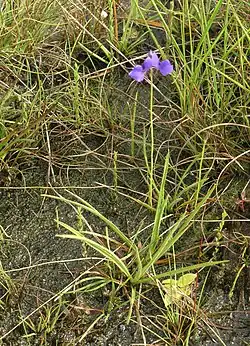Utricularia delphinioides
| Utricularia delphinioides | |
|---|---|

| |
| Scientific classification | |
| Kingdom: | Plantae |
| Clade: | Tracheophytes |
| Clade: | Angiosperms |
| Clade: | Eudicots |
| Clade: | Asterids |
| Order: | Lamiales |
| Family: | Lentibulariaceae |
| Genus: | Utricularia |
| Subgenus: | Utricularia subg. Bivalvaria |
| Section: | Utricularia sect. Oligocista |
| Species: | U. delphinioides
|
| Binomial name | |
| Utricularia delphinioides | |
| Synonyms | |
|
U. delphinioides var. minor Pellegr. | |
Utricularia delphinioides is a small to medium-sized, probably perennial, carnivorous plant that belongs to the genus Utricularia. It is endemic to Indochina and can be found in Cambodia, Laos, Thailand, and Vietnam. U. delphinioides grows as a terrestrial plant in swamps and rice fields, wet grasslands, or open pine forests at altitudes from near sea level to 1,300 m (4,265 ft). It was originally named by Clovis Thorel but formally described and published by François Pellegrin in 1920. A variety, U. delphinioides var. minor, was also described in 1920, but Peter Taylor reduced the variety to synonymy under U. delphinioides because he discovered a continuous range of sizes between the larger and smaller forms, size being the only distinctive characteristic in the 1920 description of the variety.[1]
See also
References
- ^ Taylor, Peter. (1989). The genus Utricularia - a taxonomic monograph. Kew Bulletin Additional Series XIV: London.